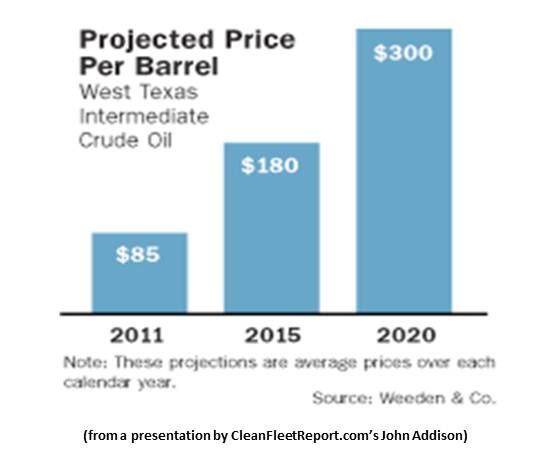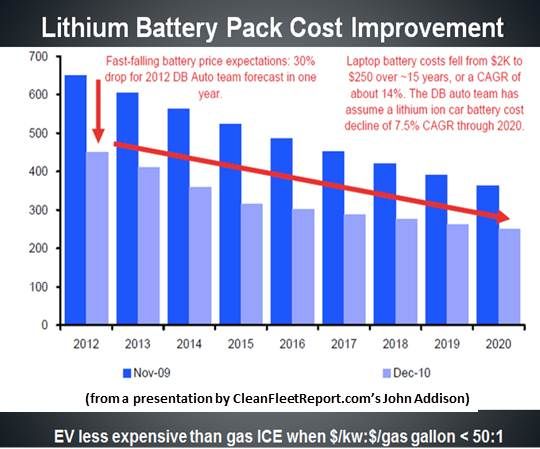What kind of vehicles will commuters use In 2022? What kind of vehicles will deliver goods? Energy storage experts at the third annual Advanced Energy Solutions symposium offered some potential answers.
US Hybrid President Abas Goodarzi:
The biggest inefficiency in transport is traffic. That’s where hybrid batteries come in. Just like a laptop or cell phone, we need to be able to have that engine go to sleep or decouple. Hybrid is the only way to do that.
For trucking, more than 50 percent of energy consumed is to move the weight. You have to dramatically change the architecture of the truck to a powered platform, especially for ports. The battery power system is in the trailer bed. Independent axles make maneuverability more efficient.
In five years, self-powered cargo handling goods movers will be in more than half of all ports and, with this, all-electric becomes feasible.
FLUX Power CEO Chris Anthony:
Petroleum products will become scarce and we will be incentivized to use electrons to push vehicles, but we will still be lithium-powered in 2022. It will more ubiquitous and cheaper. I hope maybe 20 percent to 30 percent of our vehicles will be electric.
We’ll see progress in developing countries in inexpensive electric vehicles, something that costs $5,000 or $6,000 that could last for five or ten years instead of $50,000 to $100,000 technology planned to last ten to twenty years. Over the next ten years, government subsidies will fall away and commercial markets will produce that $6,000 car.
Heavy transport vehicles will be more efficient, more lightweight. Aerodynamics will be crucial. I can imagine solar devices on long-haul trucks by 2022, if solar gets less expensive and lighter-weight. Not using 60 feet of space across the top seems silly. It could be charging the battery.

BAE Systems HybriDrive Solutions Senior Engineer Tom Apalenek:
When I was in high school, in 1976, I read an article about how everybody would be driving electric cars by the year 2000. Everybody is not driving electric cars. I think the highest likelihood is hybrids. Something electric, something with energy storage.
I don’t see a breakthrough in battery technology by 2022 that will make it possible for all-electrics to be a broad market. Batteries are running up against physics in terms of how much energy you can store and, even if you solve the battery problem, there is the charging infrastructure. Everybody today is used to being able to refuel in five minutes.

Ioxus VP Jeff Colton:
We could make an educated guess that by 2022 the CAFÉ standard is going to be around 40 miles per gallon. Currently, the approach is all-electric vehicles. I think the cost of electricity will increase faster than the cost of gasoline. And it is more difficult and more expensive to increase electric charging capacity than to increase gasoline or natural gas capacity.
There are estimates that a subsidized all-electric vehicle that might sell for $45,000, but the estimated manufacturing cost ranges from $90,000 to $250,000. Those subsidies are not going to exist in ten years. All-electric vehicles are not the answer.
Recovering wasted energy through regenerative braking is the answer. It is using less fuel, not just a different kind of fuel.
In ten years, you can recover the difference between today’s CAFÉ standards and 2022’s CAFÉ standard by recovering the energy wasted during braking. You don’t have to dramatically change the entire system and double or triple your utility's generating capability.
That’s where ultracapacitors fit. I am talking about a 30 percent gain if, every time you brake, you recover all of that energy. Ultracap technology has to advance -- but not as much as the technology necessary to make electric cars work.
Cost-wise, we are not there, but it is a more cost-effective solution than a $250,000 electric car. In two or three years, as we reduce the overall systems cost, it becomes very viable. Electric car mass adoption doesn’t work because the whole system has to change.

OPTIMARK President and CleanFleetReport.com Founder John Addison:
In 2022, if we project current trends, smart apps will make electrified, efficient modes of transportation increasingly easier to use.
We will move more slowly in long-distance trucks and airplanes. We will have more efficiency but we will still depend on petroleum fuels or, possibly, sustainable, cost-effective biofuels.
Vehicles are, on average, on the road in this country fifteen years, so it is going to be a gradual turnover. In 2022, probably at least 30 percent of personal vehicles will have an electric motor and advanced energy storage system. And the electrification of transportation could very well be the killer app of the smart grid.
It is a classic case of technology crossing the chasm. You are going see advanced technology adopted in little segments and then move into the general market. So much of whether you are optimistic or pessimistic about electric cars depends on whether you jump straight to this mass consumer market. But technology never evolves that way. It is not happening in transportation either.
The same day these ideas were collected, Westport Innovations and Clean Energy announced they will take a demonstration Peterbilt 388 heavy-haul eighteen-wheeler powered by a natural gas engine from Dallas, TX to Oklahoma City, OK using Clean Energy's new network of LNG stations.



